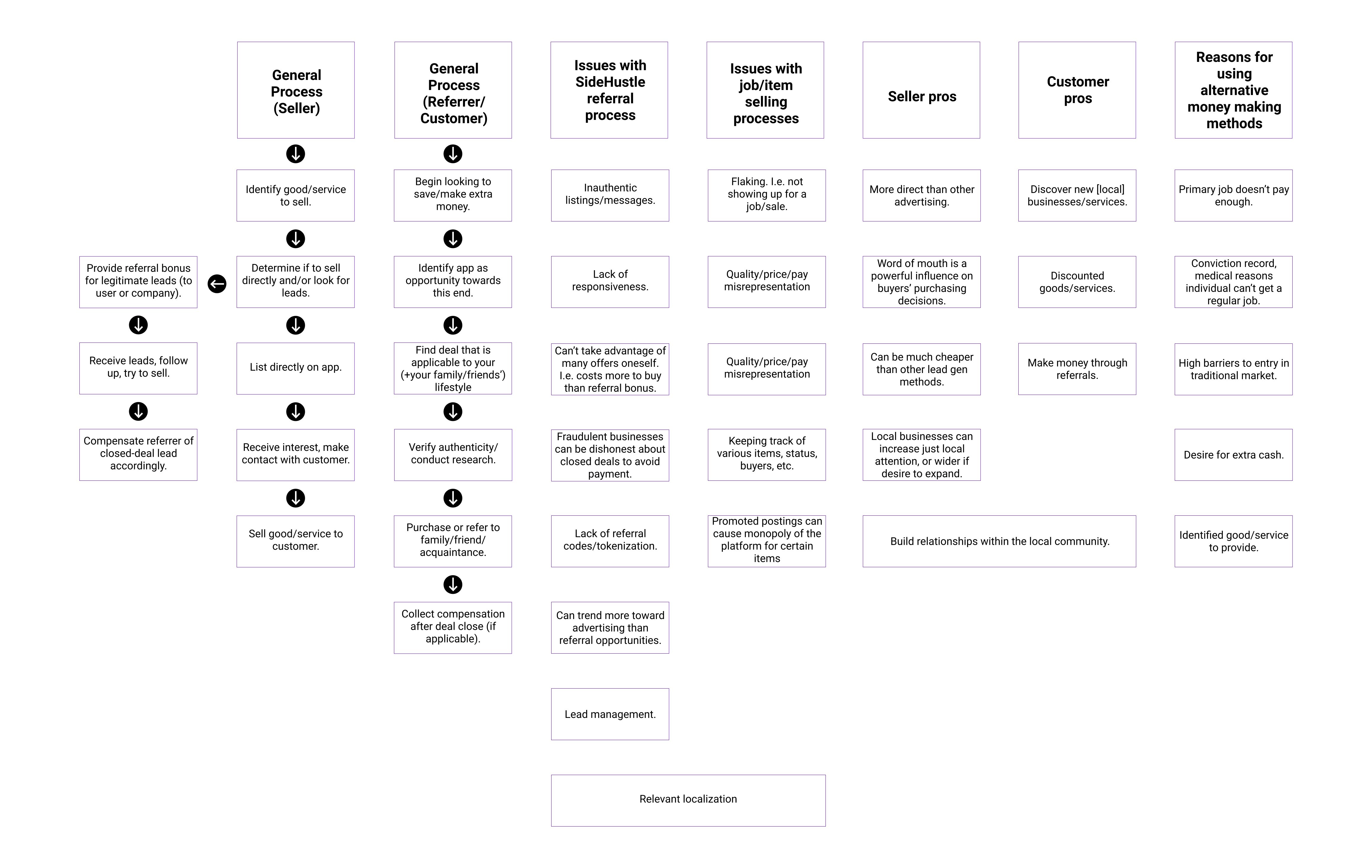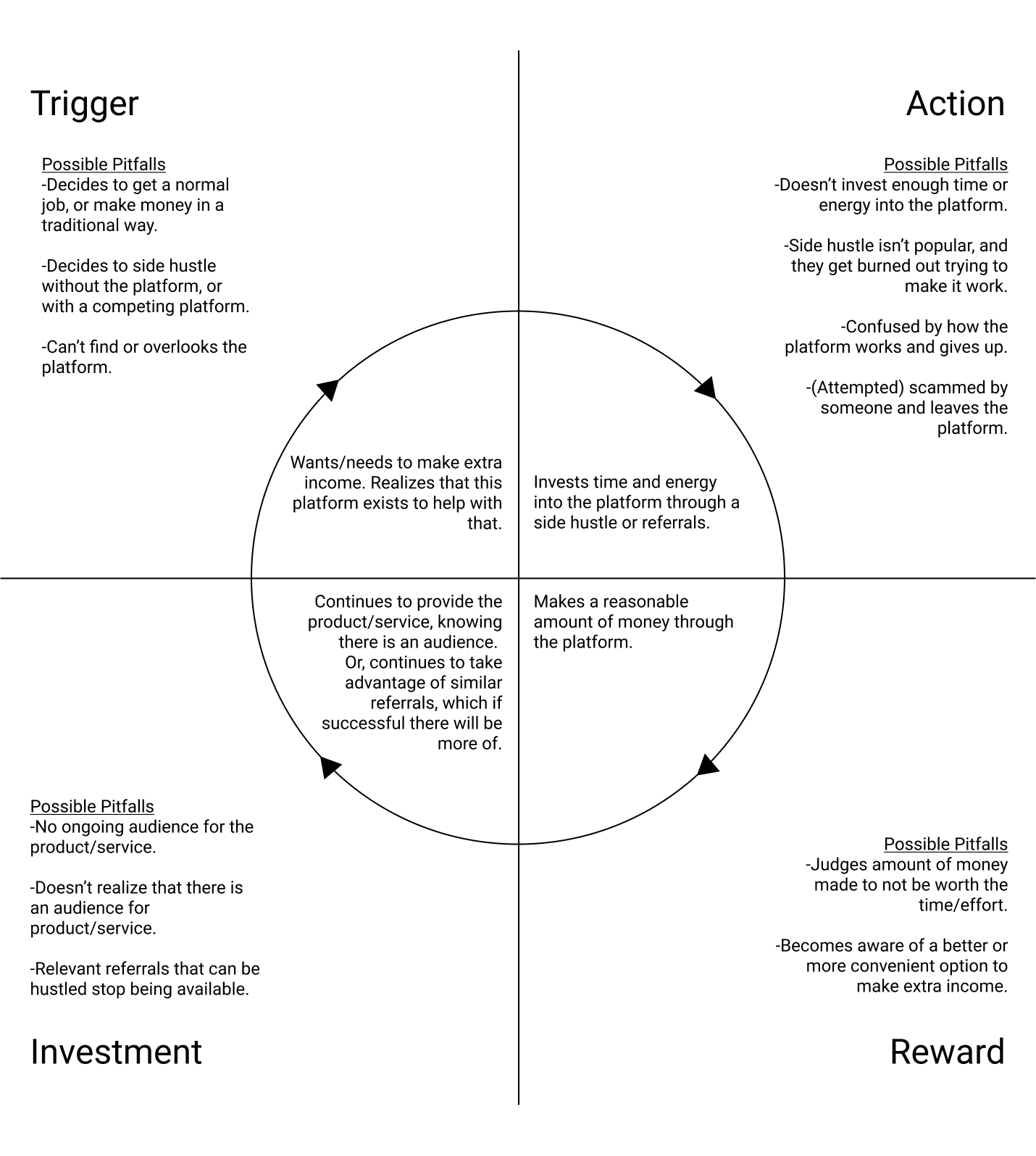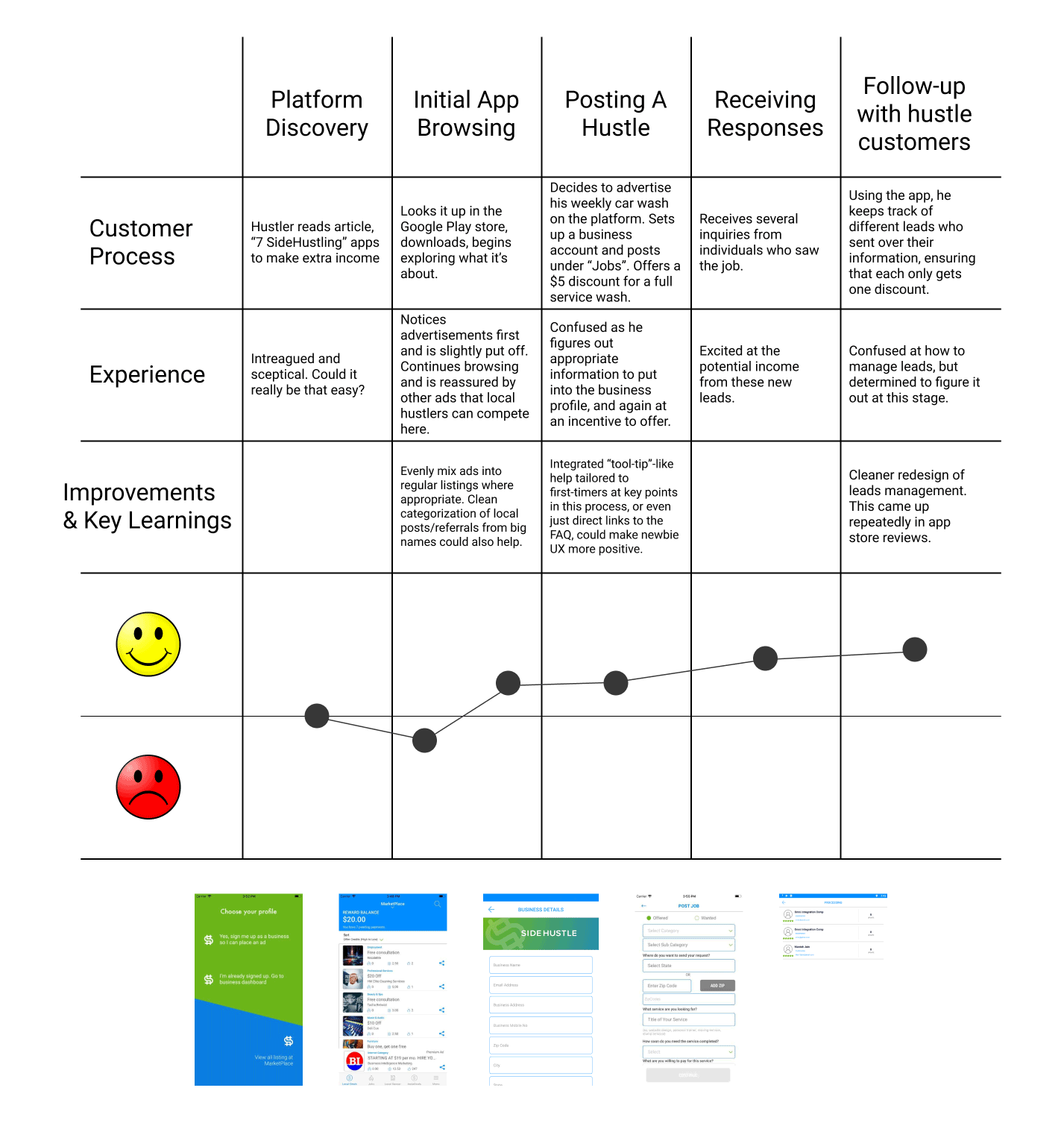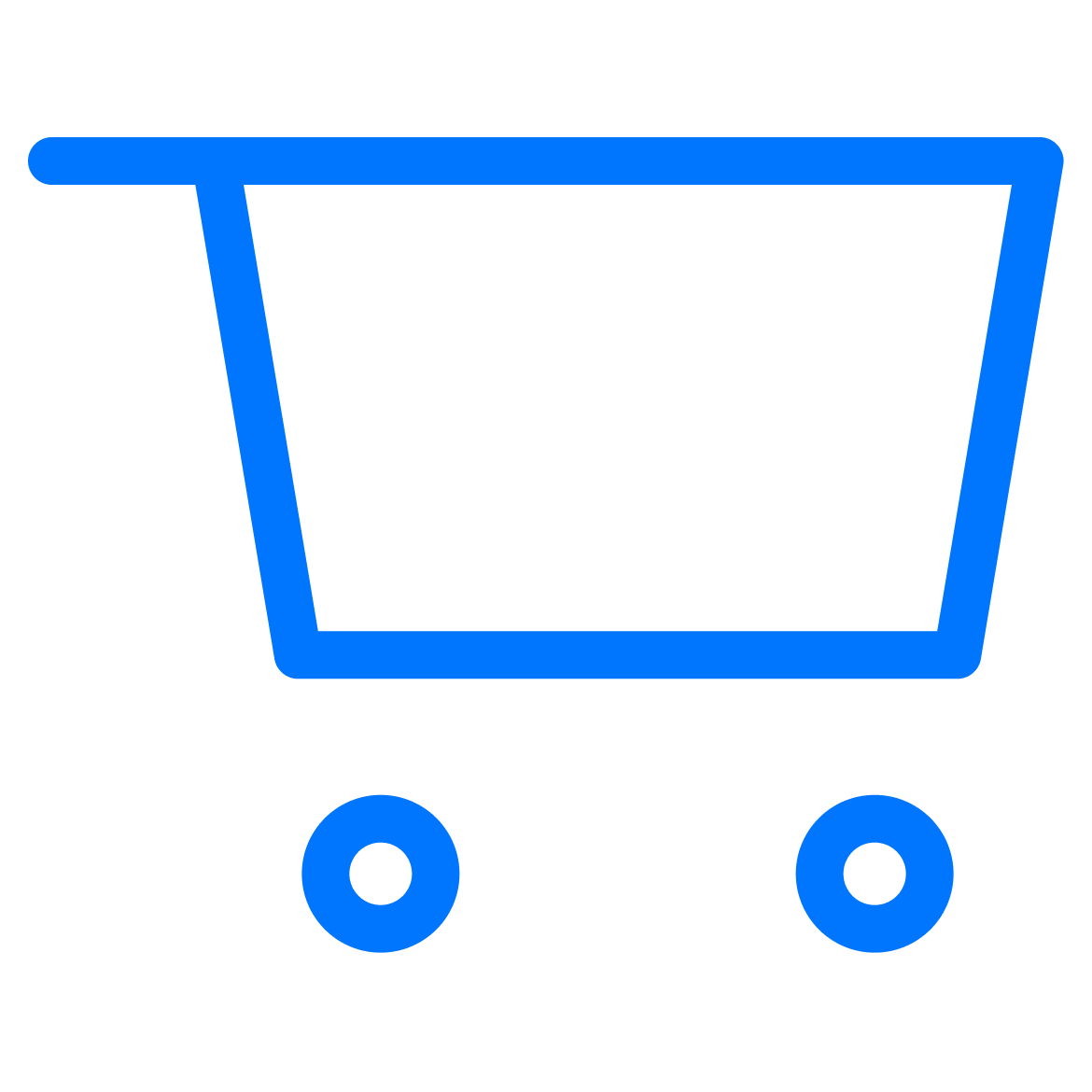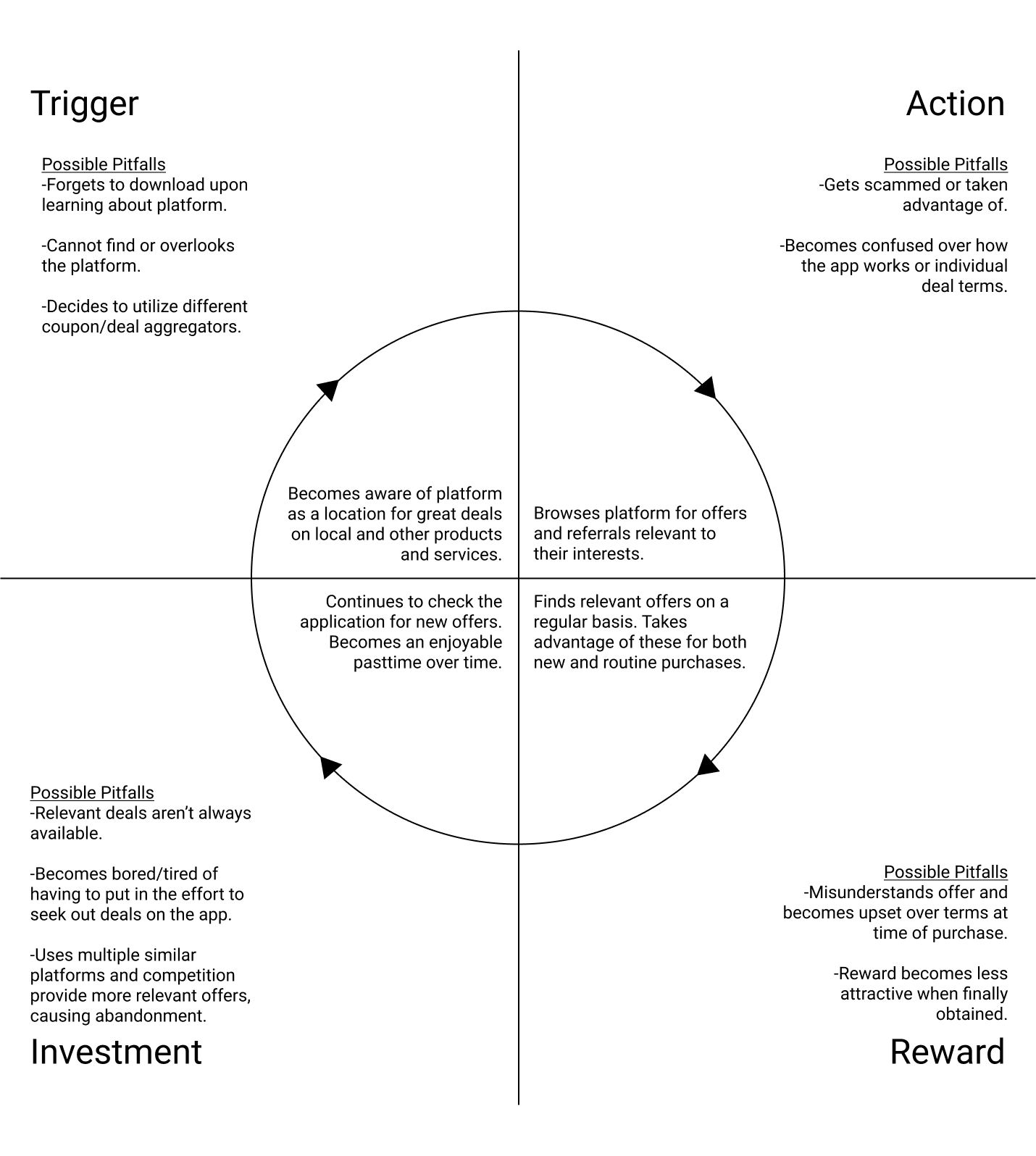
Referral Marketplace
Overview
SideHustle is a unique platform, intended for a number of different audiences. Small businesses promote their goods or services to those in their community, shoppers browse deals on goods or services that are relevant to their lifestyle, and SideHustlers earn cash for helping to make these transactions happen. At the time of my involvement with the project, version 1 had been published, several changes had been made, and the company was looking to update the look, feel, and direction of their product.
Project Goal
Create a healthy ecosystem of locally-based referral promotions, supported by national advertisers.
Duration
Sep 2019 — Jan 2020
My Roles
User/market research
UX design
UI design
Production & developer support
Research
Initial research was based around establishing a context for our users, based on original product intentions, app store reviews of SideHustle and similar applications, marketing data, customer support queries, as well as market research concerning C2C referrals. We had competitors from different segments due to our diverse target audiences:
- Competition from similar referral apps like Drum, Chums Referral, and a number of other similar platforms.
- Competition for digital advertising by small businesses and gig marketplaces, meaning giants such as Google and Facebook, as well as smaller affiliate/referral SaaS products and agencies.
- Competition for customers from deal aggregators such as Groupon.
- Competition for “SideHustlers” from a wide variety of other gig platforms such as Uber, DoorDash, and Lime.
- Competition from other job boards and marketplace applications such as Craigslist, Facebook Marketplace, and LetGo.
Findings were summarized using an affinity diagram format, helping to define our different audiences and how they might interact with the application to achieve their relevant goals.
Defining Audiences
As we he had several different audiences to consider, looking into app reviews provided great insight into various usage patterns and common issues that would come up. From this background research, we defined 5 main audiences that would likely use the platform.
The Hustler
- Wants/needs extra income.
- Has some sort of resource to sell (connections, goods, services).
- ”Hustler” mindset - cognizant of alternative ways of bringing in income.
- Somewhat business-savvy. Can recognize scams and poor deals.
Jobs to be Done
- Identify opportunities to make extra income.
- Advertise their product/service in a legitimate, appealing manner.
- Identify relevant referrals their acquaintances will want to capitalize on.
- Ensure fair payment for product/service or referral.
Overall Goal
“I’d like to make some extra income, and this application is a means to that end.”
The Socialite
- Aware of local culture and businesses.
- Highly social. Has a relatively large network of friends/acquaintances.
- Enjoys talking about personally utilized products/services.
- Not especially business-savvy. Can recognize and avoid particularly fake-sounding offers.
Jobs to be Done
- Casually share referrals to businesses they personally use or would use.
- Create common ground with friends through similar product/service utilization.
- Avoid irrelevant products or services.
Overall Goal
“I’d like to find new things to do in town with my social circle, but would be open to earning some money for referring friends.”
The Shopper
- Looking to save money on things they want/need.
- Very open to trying new products/services.
- Not business-savvy. Susceptible to scams and bad deals.
Jobs to be Done
- Socialize with friends and acquaintances.
- Find new products and services.
- Avoid irrelevant offers for products or services.
Overall Goal
“I’d like to find deals on services or things that I need or want, within my budget.”
The Small Business Owner
- Naturally invested in the local community.
- Desire to drive revenue through growing their presence in the community.
- Likely busy running their business, not much attention to focus on other things.
- Latently business-savvy. Most of what they know was learned by experience. Can be susceptible to making poor business decisions.
Jobs to be Done
- Become a fixture in the community.
- Stay competitive with online/chain and other local businesses.
- Figure out affordable ways to drive people to their business.
- Avoid adding too much complexity to their normal business processes.
- Support relevant customer needs.
Overall Goal
“I’d like to increase my business’ presence in my community and create new customers.”
The Corporate Advertiser
- Professional businessperson. Exceptionally business-savvy.
- Job hinges on making cost-conscious decisions regarding effective ad placement.
- Large pool of resources/knowledge for measuring effectiveness and cost.
Jobs to be Done
- Determine if advertising on the platform is worth the promotion cost.
- Gauge market demographics of the app for overlap with the company’s target audience.
- Identify specific metrics to measure effective promotion.
- Manage leads and referrals effectively.
- Report success to their supervisor.
Overall Goal
“I’d like to make a worthwhile investment in this platform to reach my company’s target audience.”
Defining Processes
After defining more precise audience groups and expected usage patterns, we examined the structure of the existing application in order to find ways to better align with those patterns. We mapped out current process flows, utilizing them as a basis for functionality revisions.
Findings & Initial Design
Resulting insights from the processwork and research leading to some concrete design decisions to be integrated into the early wireframe. These included:
General
- More aggressively emphasize local aspect of the platform.
- Clear differentiation between listings - for-work/for-sale, hiring/buying, local/national/international & sponsored referrals. Referral Deals and “Hustles”.
- Categorized sorting of listings/referral offers.
Referrals
- Rethink referral system. Think of some way to tokenize + associate business, referrer, referee. The current system is a huge point of various issues in the live app.
- Make affiliate links less garish. Promoted listings should have slightly different format but not be advertisement-like - similar to Twitter or Instagram.
“Hustles”
- Simplify jobs/items sold into “hustles” for recurring goods/services. Specialize away from other marketplace apps.
- Determine how involved we should get in user hustles. Provide mechanism for payment for jobs/items, etc. or just implement a messaging/contact system.
Wireframe
Several ways in which findings manifested in the application were:
- The creation of a category-based home screen to provide a more efficient experience finding relevant deals.
- Cleaner categorization of listings into referral deals, promoted deals, and “hustles”.
- A revised deal system based on these new categorizations, making use of an in-app messaging feature, account IDs and deal referral codes.
Revisions
Over several rounds of revisions, a higher-fidelity prototype of the application was designed, which incorporated insights from further discussions based on the previous research, marketing data, process flows, and other information.
Changes from the previous design included:
- Addition of primary and secondary button colors, with primary actions signifying an action that affects the system, like sending a message, publishing a listing, or confirming a cash out, and secondary actions signifying transitional moves to new screens, or preliminary actions like beginning the cash out process.
- Removal of C2C transactions completely, for an increased focus on referral/affiliate deals and a clearer value proposition overall.
- Simplification to a 3-section app hierarchy, with the overflow menu positioned at the conventional top-left of highest-level screens.
- Revisal of the “deal-close” flow to better facilitate that process.
- Addition of an onboarding, deal creation flow, and various state screens.
Prototype
Usability Testing
After the prototype was judged ready, we conducted a usability test through UserTesting in order to find any glaring issues before final iteration for development. Our 5 testers were split into 2 groups, with 3 performing tasks and giving feedback while assuming the role of hustler/shopper, and 2 doing so while assuming the role of a business owner.
Interactive Testing Prototype
Research Goals
- Determine if branding is accurately conveying the app's main purpose.
- Find points of confusion/questions when posting a referral deal.
- Determine if testers seem likely to take advantage of these kinds of referral offers.
- Find out how testers will want to use the platform. To take advantage of deals themselves, refer their friends/network, or both.
Results
Usability tests pointed toward some confusion over the main function of the application at first, but with a relatively quick learning period after some task- and self-guided exploration.
There was confusion over finding some functionality designated in tasks. As a result we:
- Included a more comprehensive “tour” post-onboarding.
- Redesigned the overflow menu to include more relevant links.
- Renamed the 3rd main section to “Activity” from “Account” to better denote contained functionality.
- Miscellaneous other changes were made based on actions of and comments from testers.
Production
The final version of the design was produced for both iOS and Android, incorporating relevant conventions and limitations of each platform.
iOS
Android
Conclusions
The final version of the design is optimized for typical usage by referral-generating “hustlers”, casual shoppers, and small to medium-sized businesses. It’s meant to make routine actions easy and undesired functionality less visible, while encouraging crossover usage from customer to business owner and vice versa.
Between the various disparate audiences and major revisions to functionality, this project presented major challenges, but allowed me to gain significant experience across research, design, and product strategy.


